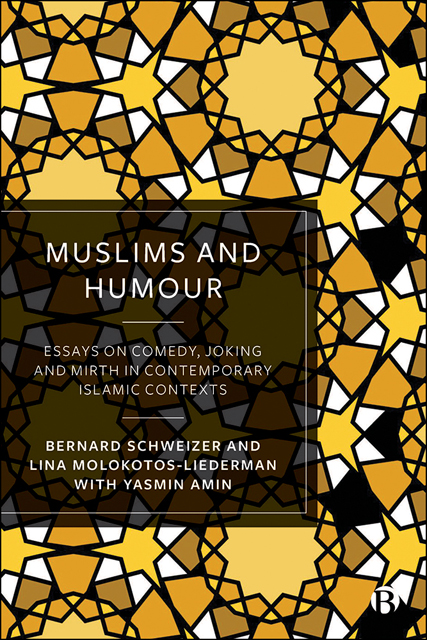Book contents
- Frontmatter
- Contents
- Notes on Contributors
- Acknowledgements
- Introduction
- Part I Theoretical Perspectives on Islam and Humour
- Part II Muslim Humour Practices in Islamicate Societies: Textual Media
- Part III Muslim Humour Practices in Islamicate Societies: Visual Media and Performance
- Part IV Muslim Comedy in North America
- Conclusion
- Bibliography on Islam and Humour
- Index
7 - Arab Cartoonists and Religion: The Interdependence of Transgression and Taboo
Published online by Cambridge University Press: 13 October 2022
- Frontmatter
- Contents
- Notes on Contributors
- Acknowledgements
- Introduction
- Part I Theoretical Perspectives on Islam and Humour
- Part II Muslim Humour Practices in Islamicate Societies: Textual Media
- Part III Muslim Humour Practices in Islamicate Societies: Visual Media and Performance
- Part IV Muslim Comedy in North America
- Conclusion
- Bibliography on Islam and Humour
- Index
Summary
Introduction
The Arab world is a vast region with different histories and political systems. The historical and political contexts are very complex, with highly dynamic developments characterizing the region and influencing media structures throughout the region. Clearly, the Arab world is not a homogenous entity and nor are its media. However, Arab countries do have a common language (in spite of the various dialects of each country), and a shared history characterized by the spread of Islam since the seventh century, the Ottoman conquest of the Arab countries, and European colonialism.
It is difficult to grasp both the heterogeneity and the common features of the Arab world and determine how these factors influence the media in general and cartooning in particular. A comprehensive and detailed study of the historical, political, social, and economic peculiarities of the different countries making up the Arab region in a short chapter is impossible. Therefore, the aim of this chapter is to focus on the broader picture and to explore the relationship between cartooning and religion by giving examples from some Arab countries. The chapter presents some initial indicative findings using individual case studies from Morocco, Tunisia, Jordan, Saudi Arabia, Egypt, and Syria.
One of the defining characteristics of the media landscape and the political climate in many Arab nations is that the freedom of the press is not an absolute right that can be taken for granted. Rather, the press operates in a contested forcefield where the need for transparent information has to be balanced with matters of decorum, restraint, and circumspection. Although the agents of censorship in Arab countries strive to stifle and subdue political satire, many cartoonists with a highly developed sense of irony and a great degree of graphic skill have creatively interpreted the red lines and boldly spoken truth to power. However, attacking politicians is one thing and criticizing religion is another, even if religious and political authorities are often intertwined. Multiple forms of censorship shape the relationship of Arab cartoonists to religion. Blasphemy laws are common in the Arab world but cartoonists face limits other than the official censor. It is difficult to mock religion in countries where religious symbols are sacred.
- Type
- Chapter
- Information
- Muslims and HumourEssays on Comedy, Joking, and Mirth in Contemporary Islamic Contexts, pp. 162 - 176Publisher: Bristol University PressPrint publication year: 2022

